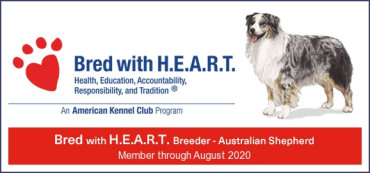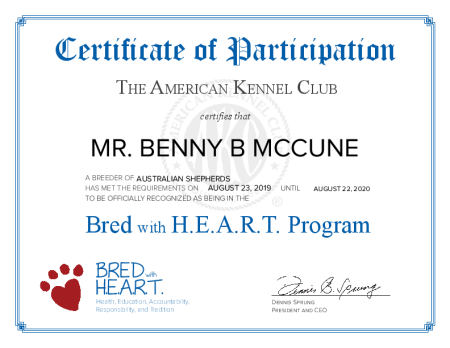

HONEYCREEKAUSSIES.COM
Australian Shepherds - The Breed that Works.
Honeycreek Australian Shepherds
We Love Our Friends
Aussie's - Loyal, Playful, Loving
The Family Welcomes You To Our World

A Whelping Checklist for the Mother to be and You.
The first 72 hours of newborn puppy care - reference points.
Giving birth to a healthy puppy or kitten is truly a miracle. There is much going on during this process and many limitations to our intervention, but we can help. Knowing what the normal process is will help dictate what you will change or support for better health in the future.
Birth:
Birthing is a traumatic process. Babies are pushed, squeezed and expelled from a warm, comfortable, floating environment into a new environment with all unknowns. Consider the fact they have never breathed air, plus they have no gag reflex to keep them from aspirating. You see the potential for issues. The importance of getting them on the ground efficiently and breathing without aspiration cannot be overstated. Once birthing has started, the high-risk baby is the one still in the uterus. This is where you can help. To ensure all goes well during the birthing process, give mom Oral Cal Plus™ when labor starts. This fast-absorbing calcium supports effective, normal contractions.
Keep Newborns Warm:
Letting babies get chilled when mom is birthing the next baby is a common mistake. Babies come out of mom at 101.5° F. In order to prevent newborns from getting chilled, make sure the whelping box is warm and give care while the next baby is coming. The experienced mom will get the baby breathing and nursing and then concentrate on the next birth. New moms often ignore the babies until the litter is on the ground. Help the new mom remove membranes and get the baby breathing if needed. If a newborn is chilled, always warm before feeding! One of the biggest causes of newborn death is hyperthermia. A mother may set a puppy to the side which makes you think she has rejected the pup, not true it is she has tried her best to warm the puppy and continues to feel coldness when licking them. So she sets the pup to the side so she may take care of the others she does not feel this condition in. By doing so she has now put that puppy at great risk of dieing due to being to cold. Remember a newborn pup cannot regulate their temperature and relies 100% on mother to keep them warm so if she cannot do it then it is all up to you. Be ready for it, get involved with the birthing process, have a alternate way to maintain the newborns body temperature and feed it if needed. You may be the newborn pups last choice to life.
Immunity:
First milk or Colostrum is full of antibodies borrowed from mom. Newborns can absorb Colostrum antibodies well during the first 12 to 24 hours. Colostrum is highly nutritious and provides disease protection to newborns during the nursing period. Newborns that don't get Colostrum from mom or are smaller than the rest of the litter can be given Nurture Mate gel Colostrum replacer. Give daily for the first three weeks to prevent disease from attacking the baby during this critical, no-Colostrum period. It is not as good as mom's Colostrum, but Nurture Mate will help you save the "runt" of the litter.
Digestion:
Newborns are born with sterile guts until exposed to the world. Bacteria is needed for normal gut digestion of milk and mom seeds good bacteria into the newborn by day three when cleaning them, but she will also seed them with bad bacteria. (You can see the need to prevent dental disease!) Giving GI Synbiotics gel proactively on the second and third day after birth will seed healthy gut bacteria needed for digestion and immune support. Babies have no gag reflex and aspirate easily, so it is best to stick with gels to avoid aspiration issues.
Umbilical Cord Care:
Because babies are born sterile, care is needed to prevent bacteria from getting into their bodies. The umbilical cord contains an artery and vein with direct access to the bloodstream. Once the umbilical is infected, the bacteria can travel up the vessels. Umbilical cord infection is one of the big causes of septicemia. Septicemia, or bad bacteria everywhere in body, is often called "Blue Belly." Most septic babies' tummies are brick red or dark red, but near death it can be blue. If a newborn is able to fend off the infection, the bacteria is often filtered out through small vessels, resulting in blocked arteries. Blocked blood vessels can cause the very end of tails, ears or toes to die and drop off.
Prevention is easy and should be done on every baby! Use an Umbilical Cord Clamp to prevent bacteria from entering the body and to prevent mom from chewing too much while cleaning. The clamp falls off after several days. Treat the umbilical with disinfectant (Iodine, Vetericyn® Super 7+ or Chlorhexidine) and repeat on day three when you remove dew claws.
Disinfectants and Cleaners:
Use caution when using cleaning products in the whelping or birthing area. Chemical residue from cleaning products and disinfectants is the number one cause of fading puppy and kitten syndrome. To keep newborns from accidentally inhaling or absorbing unwanted chemicals through their thin skin, avoid pine oils and phenols (Lysol®) as well as chlorine bleach or quaternary ammonium in the whelping nest or anywhere near babies. Use gentle cleaners with little odor and remove all residue before contact with the neonates. Chlorhexidine Solution is safe to use, even to wipe them off or disinfect an umbilical.
Whelping usually occurs with relatively few problems. The dog can usually get through it with little help from the owner. This sheet is to provide information to help you decide when an abnormality is present. Most dogs whelp about 63 days after breeding (normal range = 58-71 days). To determine exactly when she will be due, start taking your dog's rectal temperature 2-4 times daily, starting about 55 days after breeding. To take your dog's rectal temperature, you can use a human oral thermometer. Lubricate it with a little Vaseline, make sure the thermometer bulb is totally within the anus, and leave it in for at least one minute. When the dogs temperature falls to below 100 degrees F (usually below 99 degrees F), she should begin to whelp within 24 hours, and will probably begin in 4-6 hours.
You should have a place set aside for her that is warm and private. She may pick a place for herself and start nesting behavior there as she nears whelping.
Following is a list of supplies it is handy to have on hand:
Labor starts with a long stage in which the uterine contractions begin, the reproductive tract relaxes, and the cervix opens. The abdominal contractions may not be visible, but the dog will appear nervous and restless. She will be panting and may vomit. This stage lasts 6-12 hours. The second stage will be the actual birth of the puppies. You will usually see fetal tissues protruding before you actually see a pup born. The puppies will be born covered by a membrane that the dog will rupture with her teeth. She will also bite through the umbilical cord of each pup. Abdominal contractions will be evident at this stage, but it is usually best to leave the mother alone. Dogs can voluntarily stop giving birth if they are disturbed, so you should make sure she's in a quiet place. You may need to help the pups if the mother does not. Do not try to pull the puppy if it appears to be stuck, since it is very easy to harm the pups. If the mother does not clean the pups, you should dry them with a towel, wipe clear all fluid from the nose and mouth, and rub the puppies vigorously. If the mother does not sever the umbilical cord, you will have to do it. Wait for 5-10 minutes and then tie the umbilical cord in two places with thread or dental floss. The closest tie should be 1-2 inches from the body of the pup. Cut between the two ties, cleaning the end of the cord on the pup well with iodine.
Leave the pups with the mother; even though she may not let them nurse, they need her warmth and physical contact. Many mothers will eat a special treat like vanilla ice cream while whelping. Vanilla ice cream is good for them during whelping as it provides energy and calcium.
When you first see the hard abdominal contractions signaling the second stage of labor, you should give your dog several hours to have the first pup. Once you see fetal tissues protruding, she should have a pup within 30 minutes. Once she starts delivering, give her 2 hours between pups. Most dogs will have a pup every 30-60 minutes; some may have several and then rest a while before finishing. If you are unsure about whether whelping is progressing normally, please call.
The third and final stage of labor is that of expelling the placenta or afterbirth. The dog usually expels the placenta for each pup after it is born, and sometimes expels two placentas after delivering two pups. You should clean these away; there is no good physiological reason for allowing the mother to eat them. Try to count to make sure you have seen as many placentas as pups since these may be harmful to the mother if left in her uterus.
After whelping is completed, make sure all the pups nurse within 12-18 hours. The first milk they receive is very important in providing them with immunity to many common diseases. It is also important to make sure the puppies are warm enough; they should be kept in an environment of about 85 degrees F for the first several weeks of life. Be careful in your use of heating pads or heat lamps. It is very easy to burn the pups.
The mother may have a green to red-brown vulva discharge for up to three weeks after whelping. This is normal, and is of no concern as long as it is not foul-smelling and the animal seems fine otherwise. You should continue to monitor the temperature of the mother for several weeks after whelping, at least once a day. It is normal for it to be slightly elevated (102.5 - 103.0 degrees F) for 2-3 days after whelping. Inspect the mother's mammary glands daily to check for the presence of milk, any abnormal swellings, and pain. Please call if you are concerned about what you see.
The puppies should be weighed at birth and daily thereafter. They may lose a small amount of weight the first day, but should gain steadily after that, doubling their birth weight by 10-14 days of age. Tail docks and dewclaw removals, if standard for the breed, should be performed within the first five days of life.
The puppies should be started on a mash of puppy food softened with warm water, or baby rice cereal, at about four weeks of age. They can be weaned off the mother over the next two to three weeks. First vaccinations should be given at six to eight weeks of age.
If at any time you have concerns or questions, call your veterinarian. Here is a checklist of reasons to call for help:
Puppies have been being born for many years without any concerns or help from us but with a little love, understanding and sometimes a helping hand it can be done to benefit the mother and yourself. It can be a joy to see the new pup coming to life in your hands as it can be a heartbreaker to see one fade in them as well. But chances are if you are prepared, do a little research and truly want to see success then it will happen in favor of all.
Raising puppies can be difficult to the mother and you. Taking care of the mother prior to her giving birth is by all means the most important thing you can do. A health mother with all her needs taking care of has a far better chance of producing healthy puppies than a weak malnourished one. With patience, understanding and love it becomes a better ordeal for all parties involved. If puppies where not your intent then please once it is over and time for the mother to raise her puppies has been taking please take her to your vet and have her fixed so the burden of birth is no longer you and her concern.
At HoneyCreek Australian Shepherds our main goal is the health and welfare of our girls. We try really hard to have all needs taking care of during the whelping process. One of us or both are usually right by their sides during the birthing ordeal helping when and where we can. The mother and pups are in a heated whelping box, giving supplements when needed, bedding changed as needed and a whole lot of love. We are forever learning our girls and the breeds needs. I hope this has helped someone as we all need advise at times as I did and still do. If any questions have been brought up in your mind we are always just a E-Mail away to help you if we can.
Credit for the above information is given to the following sources:


